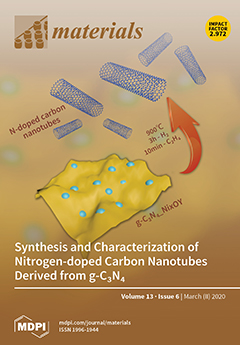Cycle-dependent damage evolution in self-healing, 2.5D woven Hi-Nicalon
TM SiC/[Si-B-C] and 2D woven Hi-Nicalon
TM SiC/[SiC-B
4C] ceramic-matrix composites (CMCs) at 600 and 1200 °C was investigated. The cycle-dependent damage parameters of internal friction, dissipated energy, Kachanov’s damage parameter, and broken fiber
[...] Read more.
Cycle-dependent damage evolution in self-healing, 2.5D woven Hi-Nicalon
TM SiC/[Si-B-C] and 2D woven Hi-Nicalon
TM SiC/[SiC-B
4C] ceramic-matrix composites (CMCs) at 600 and 1200 °C was investigated. The cycle-dependent damage parameters of internal friction, dissipated energy, Kachanov’s damage parameter, and broken fiber fraction were obtained to describe damage development in self-healing CMCs. The relationships between cycle-dependent damage parameters and multiple fatigue damage mechanisms were established. The experimental fatigue damage development of self-healing Hi-Nicalon
TM SiC/[Si-B-C] and Hi-Nicalon
TM SiC/[SiC-B
4C] composites was predicted for different temperatures, peak stresses, and loading frequencies. The cycle-dependent damage evolution of self-healing Hi-Nicalon
TM SiC/[Si-B-C] and Hi-Nicalon
TM SiC/[SiC-B
4C] composites depends on temperature, testing environment, peak stress, and loading frequency. For the Hi-Nicalon
TM SiC/[Si-B-C] composite, temperature is a governing parameter for the fatigue process. At an elevated temperature of 600 °C in an air atmosphere, the internal frictional parameter of Hi-Nicalon
TM SiC/[Si-B-C] composite decreases first and then increases with applied cycle number; however, at an elevated temperature of 1200 °C in an air atmosphere, the internal frictional parameter of Hi-Nicalon
TM SiC/[Si-B-C] composite decreases with applied cycle number, and the interface shear stress at 1200 °C is much lower than that at 600 °C. For Hi-Nicalon
TM SiC/[SiC-B
4C] composite at 1200 °C, loading frequency is a governing parameter for the fatigue process. The degradation rate of interface shear stress is much higher at the loading frequency of 0.1 Hz than that at the loading frequency of 1 Hz.
Full article






